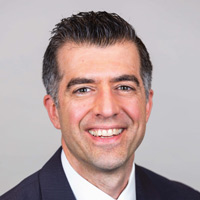Have You Reviewed Your 401(k) Beneficiary Designations Lately?
If you've had any life changes — marriage, divorce, a new baby or retirement — you might want to make sure your beneficiaries are in order.


Beneficiary decisions are a crucial yet often overlooked step when planning for retirement. Simply having a will does not mean your estate plan is fully covered.
If you die without a will or your will and 401(k) beneficiary are different, the beneficiary designation overrides the will — and it’s largely irreversible.
This is why it’s important to review your beneficiaries periodically and update if need be, especially when going through a major life change such as marriage, divorce, birth, death or retirement.
From just $107.88 $24.99 for Kiplinger Personal Finance
Become a smarter, better informed investor. Subscribe from just $107.88 $24.99, plus get up to 4 Special Issues

Sign up for Kiplinger’s Free Newsletters
Profit and prosper with the best of expert advice on investing, taxes, retirement, personal finance and more - straight to your e-mail.
Profit and prosper with the best of expert advice - straight to your e-mail.
Heath Ledger is a famous example — he died in 2008 before he updated his estate plan to include his daughter, Matilda, leaving everything to his parents and three sisters. Fortunately, his family gave all the money to his daughter.
Still, one never knows, so it’s best to use life events as times to update your beneficiaries.
Here are some things to consider as you review your beneficiaries:
A primary beneficiary is the first recipient if the owner passes. For example, if a husband passes and his wife is the primary beneficiary, then the wife will inherit the asset. A contingent beneficiary comes into play only when the primary is deceased. Think of a contingent beneficiary as the backup to the primary.
In order for a contingent beneficiary to inherit the asset, all of the primary beneficiaries must have predeceased them. For example, if Sarah and Jane are primary beneficiaries, and Luke is the contingent and Sarah passes, Jane is the sole beneficiary. Luke is still the contingent. Luke will become the primary only if Sarah and Jane both pass.
Another essential part of naming beneficiaries is understanding the difference between per stirpes and per capita distribution when a beneficiary dies before the estate owner.
Per stirpes means the inheritance goes to the beneficiary’s descendants (the children, grandchildren of the deceased beneficiary).
Per capita distribution means that the beneficiary’s inheritance is divided equally among the remaining living beneficiaries, instead of passing down to their descendants.
In other words, per stirpes ensures a deceased beneficiary’s share stays in that bloodline, while per capita ensures the surviving listed beneficiaries inherit the asset.
This is important for families with a mixed marriage. Let’s say a husband and wife have children from separate marriages. The husband and wife both pass away, leaving a 401(k) to their contingent beneficiaries, his son Peter and her daughter Beth, split 50/50.
But if Beth is no longer living, under a per capita distribution, Beth’s share goes to Peter. Under a per stirpes distribution, Beth’s share goes to her kids or grandkids, keeping it in her bloodline, and Peter gets the other 50%.
Trusts and beneficiary planning
Trusts can also help with beneficiary planning. Using a trust as a beneficiary can be helpful when beneficiaries are minors, have special needs or may not be financially responsible. A trust specifies how and when assets are distributed so they can be given in stages rather than a lump sum, which can prevent reckless spending.
Looking for expert tips to grow and preserve your wealth? Sign up for Building Wealth, our free, twice-weekly newsletter.
A trust can also protect assets from creditors, divorce or legal issues.
However, naming a trust as a beneficiary can be expensive and complicated — it’s not for everyone.
Trusts are also taxed at higher income tax rates than individuals, and trusts can be difficult to change if irrevocable. It’s best to consult with a tax or financial professional beforehand.
There are many benefits of having a proper estate plan, including saving your loved ones from legal and financial headaches in the future. Planning for your primary and contingent beneficiaries, understanding distribution structures and considering a trust are important details when it comes to retirement planning.
A tax or financial professional can help you regularly review your choices and update them as your life changes so that your assets are distributed as intended.
For more information, please email Michael Aloi at maloi@sfr1.com.
Juliet Stempler contributed to this article.
Investment advisory and financial planning services are offered through Summit Financial LLC, a SEC Registered Investment Adviser, 4 Campus Drive, Parsippany, NJ 07054. Tel. 973-285-3600. This material is for your information and guidance and is not intended as legal or tax advice. Clients should make all decisions regarding the tax and legal implications of their investments and plans after consulting with their independent tax or legal advisers. Individual investor portfolios must be constructed based on the individual’s financial resources, investment goals, risk tolerance, investment time horizon, tax situation and other relevant factors. Past performance is not a guarantee of future results. The views and opinions expressed in this article are solely those of the author and should not be attributed to Summit Financial LLC. Summit is not responsible for hyperlinks and any external referenced information found in this article.
Related Content
- All About Designating Beneficiaries in Estate Planning
- Naming Beneficiaries for Inherited IRAs: What You Need to Know
- Who Will Be the Beneficiaries of Your Wealth?
- Market Turmoil: What History Tells Us About Current Volatility
- Why Company Stock May Be Riskier Than Employees Realize
Profit and prosper with the best of Kiplinger's advice on investing, taxes, retirement, personal finance and much more. Delivered daily. Enter your email in the box and click Sign Me Up.

Michael Aloi is a CERTIFIED FINANCIAL PLANNER™ Practitioner and Accredited Wealth Management Advisor℠ with Summit Financial, LLC. With 21 years of experience, Michael specializes in working with executives, professionals and retirees. Since he joined Summit Financial, LLC, Michael has built a process that emphasizes the integration of various facets of financial planning. Supported by a team of in-house estate and income tax specialists, Michael offers his clients coordinated solutions to scattered problems.
-
 Stocks Slip to Start Fed Week: Stock Market Today
Stocks Slip to Start Fed Week: Stock Market TodayWhile a rate cut is widely expected this week, uncertainty is building around the Fed's future plans for monetary policy.
-
 December Fed Meeting: Live Updates and Commentary
December Fed Meeting: Live Updates and CommentaryThe December Fed meeting is one of the last key economic events of 2025, with Wall Street closely watching what Chair Powell & Co. will do about interest rates.
-
 This Is Why Investors Shouldn't Romanticize Bitcoin
This Is Why Investors Shouldn't Romanticize BitcoinInvestors should treat bitcoin as the high-risk asset it is. A look at the data indicates a small portfolio allocation for most investors would be the safest.
-
 Stocks Slip to Start Fed Week: Stock Market Today
Stocks Slip to Start Fed Week: Stock Market TodayWhile a rate cut is widely expected this week, uncertainty is building around the Fed's future plans for monetary policy.
-
 December Fed Meeting: Live Updates and Commentary
December Fed Meeting: Live Updates and CommentaryThe December Fed meeting is one of the last key economic events of 2025, with Wall Street closely watching what Chair Powell & Co. will do about interest rates.
-
 Why Investors Shouldn't Romanticize Bitcoin, From a Financial Planner
Why Investors Shouldn't Romanticize Bitcoin, From a Financial PlannerInvestors should treat bitcoin as the high-risk asset it is. A look at the data indicates a small portfolio allocation for most investors would be the safest.
-
 I'm a Financial Pro Focused on Federal Benefits: These Are the 2 Questions I Answer a Lot
I'm a Financial Pro Focused on Federal Benefits: These Are the 2 Questions I Answer a LotMany federal employees ask about rolling a TSP into an IRA and parsing options for survivor benefits, both especially critical topics.
-
 Private Credit Can Be a Resilient Income Strategy for a Volatile Market: A Guide for Financial Advisers
Private Credit Can Be a Resilient Income Strategy for a Volatile Market: A Guide for Financial AdvisersAdvisers are increasingly turning to private credit such as asset-based and real estate lending for elevated yields and protection backed by tangible assets.
-
 I Retired at 63 to Enjoy My Free Time but My Grown Kids Want Help With Child Care. I Love My Grandkids, but It's Too Much. What Should I Do?
I Retired at 63 to Enjoy My Free Time but My Grown Kids Want Help With Child Care. I Love My Grandkids, but It's Too Much. What Should I Do?We asked therapists and relationship experts for advice.
-
 5 RMD Mistakes That Could Cost You Big-Time: Even Seasoned Retirees Slip Up
5 RMD Mistakes That Could Cost You Big-Time: Even Seasoned Retirees Slip UpThe five biggest RMD mistakes retirees make show that tax-smart retirement planning should start well before you hit the age your first RMD is due.
-
 I'm a Wealth Adviser: My 4 Guiding Principles Could Help You Plan for Retirement Whether You Have $10,000 or $10 Million
I'm a Wealth Adviser: My 4 Guiding Principles Could Help You Plan for Retirement Whether You Have $10,000 or $10 MillionRegardless of your net worth, you deserve a detailed retirement plan backed by a solid understanding of your finances.